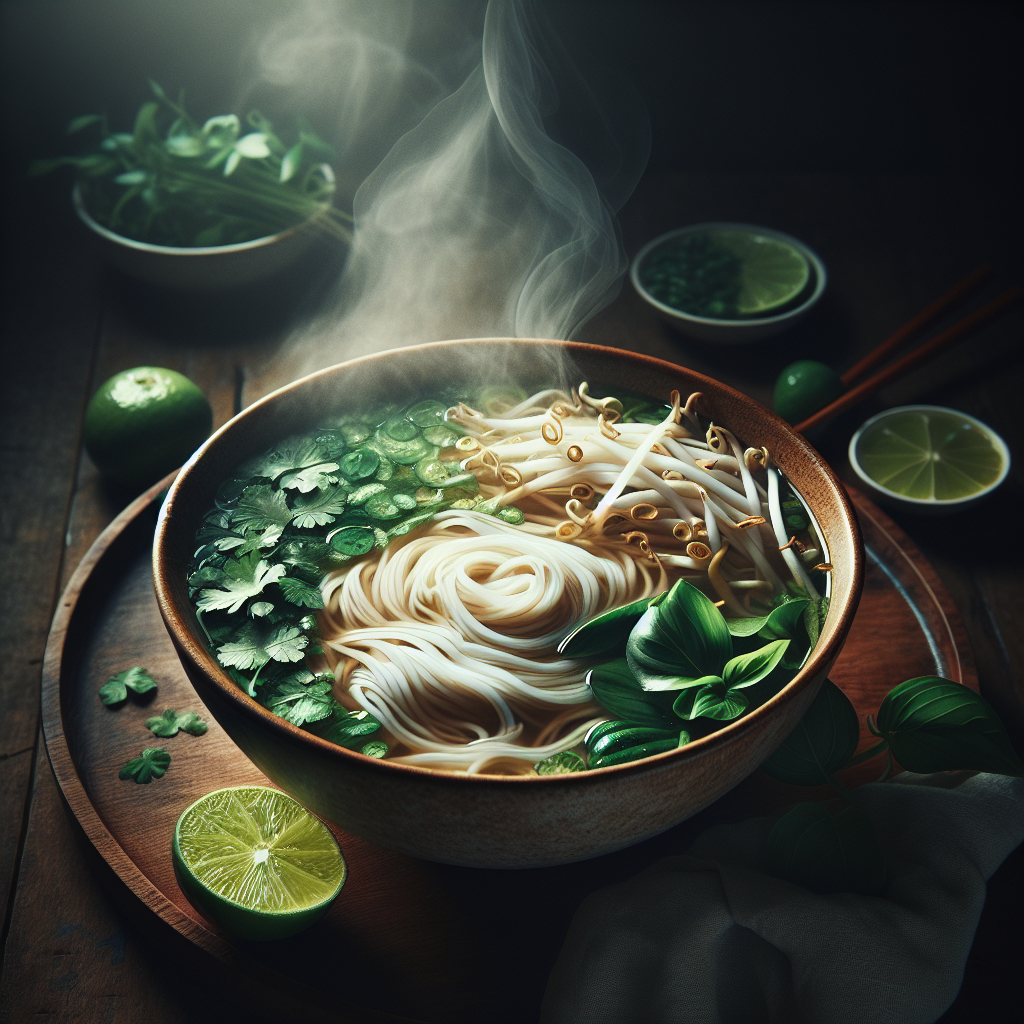In this article, Tastepan.com invites you to dive into the vibrant and mouth-watering world of Vietnamese cuisine. Get ready to indulge your taste buds in the culinary heritage of Vietnam, as we explore the iconic dishes of Pho, Banh Mi, and the tempting array of street food. From the savory broth of Pho to the crunchy baguette of Banh Mi, each dish tells a story of centuries-old traditions and cultural influences. Join us on a flavorful journey that will leave you craving more.

The Culinary Heritage of Vietnam
Introduction
Welcome to the captivating world of Vietnamese cuisine, where flavors, aromas, and textures come together in perfect harmony! Vietnam is renowned for its rich culinary heritage, which reflects the country’s vibrant history and diverse cultural influences. In this article, we will take a deep dive into three of Vietnam’s most iconic dishes – Pho, Banh Mi, and Street Food – and explore the regional specialties, traditional cooking techniques, and the influence of Vietnamese cuisine on the world stage.
Overview of Vietnamese Cuisine
Vietnamese cuisine is a tantalizing blend of fresh herbs, vegetables, meats, and aromatic spices. It is known for its delicate balance of flavors – a symphony of sweet, sour, salty, and spicy that harmoniously dance on your taste buds. Vietnamese cuisine is characterized by its emphasis on fresh, light ingredients, making it a perfect choice for those seeking a healthy and flavorful culinary experience.
Historical Influences
Vietnamese cuisine is a beautiful amalgamation of the country’s rich history and its interactions with neighboring cultures. Chinese influence can be traced back to ancient times, during which Vietnamese cooking techniques and ingredients were heavily influenced by the Chinese. The arrival of the French in the 19th century introduced a whole new array of ingredients and techniques, giving birth to a unique fusion of flavors. Additionally, the country’s tropical climate and proximity to the sea have played a significant role in shaping Vietnamese cuisine, with an abundance of fresh seafood and tropical fruits making their way into traditional dishes.
Pho
Origin and History
Pho, the beloved Vietnamese noodle soup, has a storied history that dates back to the early 20th century. It is believed to have originated in northern Vietnam and was initially enjoyed by the working class as a hearty breakfast option. Over time, its popularity spread throughout the country, eventually becoming a national dish. Pho gained international recognition during the Vietnam War when American soldiers discovered its comforting and nourishing qualities.
Ingredients and Preparation
The heart and soul of Pho lies in its flavorful broth, which is made by simmering beef bones, aromatic spices like star anise, cloves, and cinnamon, and charred onions and ginger for hours. The slow-cooked broth is then ladled over rice noodles and topped with thinly sliced beef or chicken, along with an array of garnishes like fresh herbs, bean sprouts, and lime. The combination of the hearty broth, tender meat, and refreshing toppings creates a medley of textures and flavors that is simply irresistible.
Regional Variations
While Pho is enjoyed throughout Vietnam, it is worth noting that there are subtle regional variations that make each bowl unique. Northern-style Pho tends to have a clearer and milder broth, with slices of rare beef or well-done beef. In the central region, Pho is typically sweeter and features a wider range of toppings, including various types of beef and even pork. Southern-style Pho is known for its robust and flavorful broth, often incorporating more herbs and spices, and may include additional cuts of meat such as tendon and tripe. These regional variations add diversity to this beloved Vietnamese dish.

Banh Mi
A Fusion of Flavors
Banh Mi is a quintessential Vietnamese sandwich that beautifully showcases the fusion of culinary influences in the country. Its origins can be traced back to the French colonization period when the French introduced baguettes to Vietnam. The Vietnamese people embraced the humble baguette and infused it with their own vibrant flavors and ingredients, giving birth to the beloved Banh Mi.
Key Ingredients
The key to the Banh Mi’s irresistible flavor lies in the combination of contrasting elements. The crispy and fluffy baguette is traditionally filled with a variety of ingredients, including marinated and grilled meats such as pork, chicken, or beef, along with pickled daikon and carrots, fresh cucumbers, cilantro, and a slathering of pate and mayonnaise. This harmonious blend of textures and flavors creates a culinary symphony that is simply delightful.
Popular Varieties
Banh Mi comes in a wide array of varieties, catering to different tastes and preferences. One popular variant is Banh Mi Thit Nuong, which features succulent grilled pork. Banh Mi Ga offers a delectable filling of tender shredded chicken. For seafood lovers, there is Banh Mi Ca Moi, which includes crispy fish fillet. Vegetarians are not left behind, as Banh Mi Chay offers a delightful mix of tofu, mushrooms, and assorted vegetables. Regardless of the variety, Banh Mi is a delightful culinary experience that is sure to leave you craving for more.
Street Food
Vibrant Food Culture
Street food holds a special place in Vietnamese culinary culture and provides a unique glimpse into the country’s vibrant food scene. The bustling streets of Vietnam are adorned with vibrant food stalls and night markets, offering a wide range of delectable snacks and meals. Street food is not only a convenient and affordable option for locals but also a thrilling adventure for travelers seeking to immerse themselves in the authentic flavors of Vietnam.
Iconic Street Food Dishes
Vietnam’s street food scene boasts a plethora of iconic dishes that are must-tries for any food enthusiast. The tantalizing aroma of Banh Xeo, a crispy and savory pancake filled with shrimp and bean sprouts, will surely captivate your senses. Bite into the juicy and flavorful Bahn Bot Loc, a chewy tapioca dumpling filled with shrimp and pork, or savor the addictive grilled pork skewers known as Nem Nuong. The options are endless, with each dish offering a unique and unforgettable culinary experience.
Night Markets and Food Stalls
Vietnam’s night markets and food stalls are an integral part of the culinary landscape, providing a feast for the senses. These vibrant hubs of gastronomic delights offer an assortment of dishes, from smoky grilled meats and seafood to steaming bowls of noodles. Stroll through these bustling markets, immerse yourself in the lively atmosphere, and sample the eclectic array of flavors that Vietnam has to offer.

Regional Specialties
Northern Cuisine
The northern region of Vietnam is known for its unique and hearty cuisine. The colder climate has influenced the food culture, with dishes like Pho Bac (northern-style Pho) being popular comfort foods. Another iconic dish from the north is Cha Ca, which features turmeric-marinated fish that is fried at your table and served with a medley of fresh herbs and rice noodles. The cuisine of the north is characterized by its simplicity and the use of bold and earthy flavors.
Central Cuisine
Central Vietnam is famed for its exquisite cuisine, which offers a balance of flavors and ingredients from both the north and the south. One standout dish is Cao Lau, a rice noodle dish topped with pork, herbs, and crispy rice crackers. Another delicacy is Banh Canh, a thick and chewy noodle soup showcasing an assortment of seafood or pork. The flavors in central Vietnamese cuisine tend to be bolder, with a focus on aromatic herbs and condiments.
Southern Cuisine
The cuisine of southern Vietnam is heavily influenced by the fertile Mekong Delta and the country’s close proximity to Cambodia. The region is renowned for its flavorful dishes that incorporate a wide range of ingredients. One iconic dish is Hu Tieu, a clear and aromatic noodle soup that features a mix of pork, seafood, and an array of herbs and vegetables. The cuisine of the south is characterized by its bold and complex flavors, with the generous use of sugar, fish sauce, and spicy chilies.
Traditional Cooking Techniques
Stir-Frying
Stir-frying is a fundamental cooking technique in Vietnamese cuisine. It involves quickly cooking ingredients over high heat in a wok or skillet, resulting in a perfect balance of textures and flavors. The rapid cooking process ensures that vegetables retain their vibrant colors and crispness, while meats remain tender and juicy.
Steaming
Steaming is another popular cooking technique used in Vietnamese cuisine, particularly for seafood and vegetables. Steaming allows for gentle and even cooking, preserving the natural flavors and nutrients of the ingredients. It is a healthier alternative to frying and provides a light and delicate texture to the dishes.
Grilling
Grilling is deeply rooted in Vietnamese culinary traditions and is a favorite cooking method for meats, seafood, and even vegetables. Grilling imparts a smoky flavor and a charred caramelization to the ingredients, adding depth and complexity to the dishes. From grilled pork skewers to flame-kissed fish, grilling is a technique that truly elevates Vietnamese cuisine.
Boiling
Boiling is a simple yet essential cooking technique in Vietnamese cuisine, utilized in making broths, soups, and poaching ingredients. The long simmering process extracts rich flavors from bones, aromatic spices, and vegetables, resulting in deeply flavorful broths that form the base of iconic dishes like Pho.
Vietnamese Culinary Techniques
Fermentation
Fermentation is an ancient technique widely used in Vietnamese cuisine, adding depth and complexity to dishes. The process involves breaking down natural sugars in ingredients, creating a unique umami flavor profile. Fish sauce, a staple condiment in Vietnamese cooking, is made through a fermentation process that enhances its flavor and aroma. Other fermented items like pickles and fermented soybean paste further exemplify the Vietnamese love for this traditional technique.
Herbal Medicine Integration
Vietnamese cuisine has a deep connection with herbal medicine, with many dishes incorporating herbs and plants renowned for their health benefits. Ingredients like lemongrass, ginger, and turmeric are not only used to enhance flavors but also valued for their medicinal properties. Vietnamese culinary traditions place a great emphasis on the holistic benefits that food can offer.
Color Palette
Vietnamese cuisine is as visually enticing as it is delicious, with an emphasis on creating vibrant and colorful dishes. From the vibrant greens of fresh herbs and vegetables to the bright reds of chili peppers and tomatoes, Vietnamese cuisine celebrates the visual appeal of food. The skillful use of colorful ingredients adds beauty to every plate, making the dining experience even more delightful.
Influence on International Cuisine
Global Popularity of Pho and Banh Mi
Vietnamese cuisine has gained international acclaim, with Pho and Banh Mi becoming culinary staples in many countries around the world. The hearty and comforting flavors of Pho have captured the hearts of food lovers everywhere, while the explosion of flavors in Banh Mi has made it a popular street food choice. Vietnamese restaurants and food trucks are thriving in numerous cities, bringing the taste of Vietnam to global audiences.
Vietnamese Chefs around the World
Vietnamese chefs have made a mark on the global culinary stage, showcasing their talent and passion for Vietnamese cuisine. From mastering the art of Pho to developing innovative twists on traditional dishes, these chefs have played a pivotal role in introducing the depth and complexity of Vietnamese flavors to the world. Their dedication to preserving culinary traditions while pushing the boundaries of creativity has made Vietnamese cuisine a force to be reckoned with.
Maintaining Tradition in Modern Times
Preserving Authentic Recipes
In modern times, there is a growing appreciation for preserving the authenticity of traditional Vietnamese recipes. Chefs and home cooks alike are committed to upholding the integrity of classic dishes, staying true to the time-tested methods and flavors that make Vietnamese cuisine so special. The passing down of recipes through generations ensures that the cultural heritage and culinary legacy of Vietnam will continue to thrive.
Incorporating Modern Cooking Techniques
While tradition plays a significant role, Vietnamese cuisine has also embraced modern cooking techniques to meet the demands of evolving palates. Chefs are continuously experimenting with new flavors and techniques, infusing traditional dishes with contemporary twists. By combining modern culinary trends with the rich heritage of Vietnam, chefs are able to push the boundaries of Vietnamese cuisine while maintaining its essence.
Vietnamese cuisine is a treasure trove of captivating flavors, rich traditions, and culinary innovations. Whether you’re indulging in a steaming bowl of Pho or savoring the crunch of a Banh Mi, you are immersing yourself in a culinary journey that encapsulates the heart and soul of Vietnam. As you navigate the diverse landscapes of Vietnamese cuisine, you will discover a tapestry of flavors that will leave an everlasting impression and a desire to explore further. So grab your chopsticks and embark on this gastronomic adventure – Vietnam awaits!

